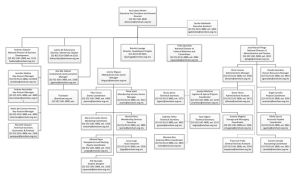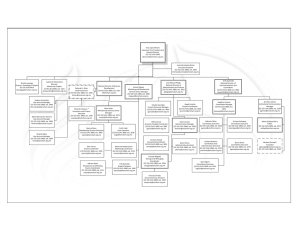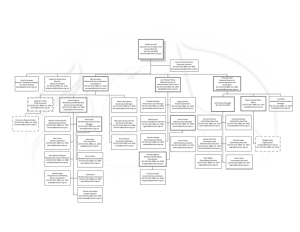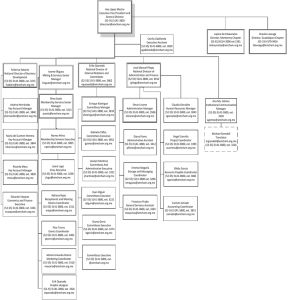Fluorescence probes for both prokaryotic and eukaryotic cells using
Anuncio
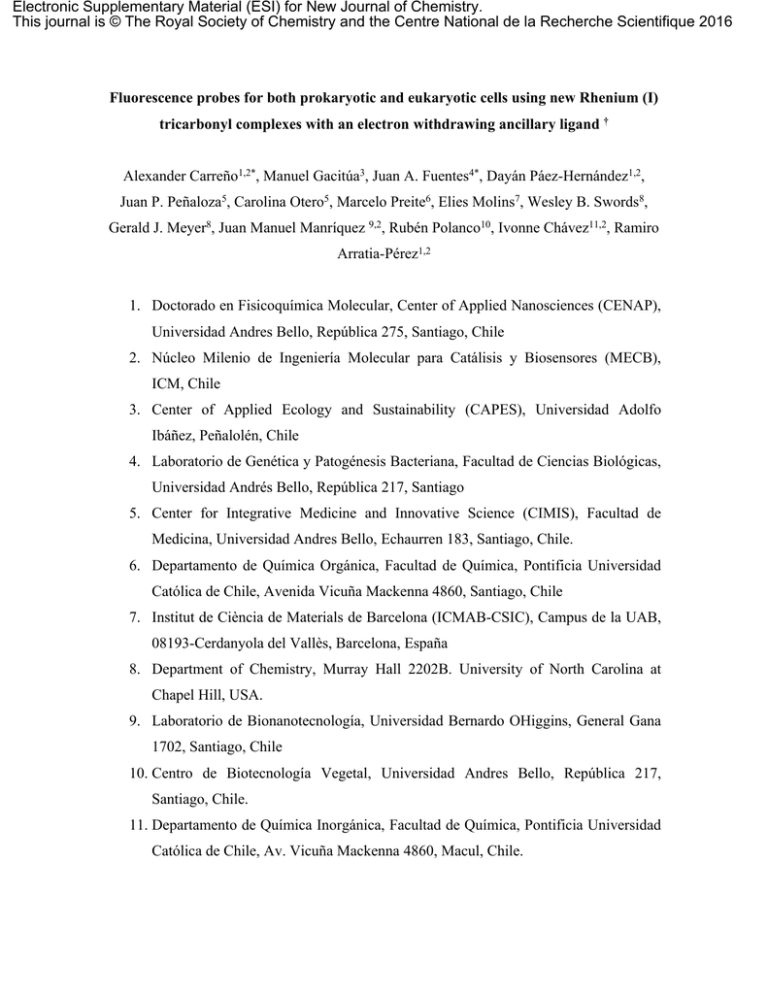
Electronic Supplementary Material (ESI) for New Journal of Chemistry. This journal is © The Royal Society of Chemistry and the Centre National de la Recherche Scientifique 2016 Fluorescence probes for both prokaryotic and eukaryotic cells using new Rhenium (I) tricarbonyl complexes with an electron withdrawing ancillary ligand † Alexander Carreño1,2*, Manuel Gacitúa3, Juan A. Fuentes4*, Dayán Páez-Hernández1,2, Juan P. Peñaloza5, Carolina Otero5, Marcelo Preite6, Elies Molins7, Wesley B. Swords8, Gerald J. Meyer8, Juan Manuel Manríquez 9,2, Rubén Polanco10, Ivonne Chávez11,2, Ramiro Arratia-Pérez1,2 1. Doctorado en Fisicoquímica Molecular, Center of Applied Nanosciences (CENAP), Universidad Andres Bello, República 275, Santiago, Chile 2. Núcleo Milenio de Ingeniería Molecular para Catálisis y Biosensores (MECB), ICM, Chile 3. Center of Applied Ecology and Sustainability (CAPES), Universidad Adolfo Ibáñez, Peñalolén, Chile 4. Laboratorio de Genética y Patogénesis Bacteriana, Facultad de Ciencias Biológicas, Universidad Andrés Bello, República 217, Santiago 5. Center for Integrative Medicine and Innovative Science (CIMIS), Facultad de Medicina, Universidad Andres Bello, Echaurren 183, Santiago, Chile. 6. Departamento de Química Orgánica, Facultad de Química, Pontificia Universidad Católica de Chile, Avenida Vicuña Mackenna 4860, Santiago, Chile 7. Institut de Ciència de Materials de Barcelona (ICMAB-CSIC), Campus de la UAB, 08193-Cerdanyola del Vallès, Barcelona, España 8. Department of Chemistry, Murray Hall 2202B. University of North Carolina at Chapel Hill, USA. 9. Laboratorio de Bionanotecnología, Universidad Bernardo OHiggins, General Gana 1702, Santiago, Chile 10. Centro de Biotecnología Vegetal, Universidad Andres Bello, República 217, Santiago, Chile. 11. Departamento de Química Inorgánica, Facultad de Química, Pontificia Universidad Católica de Chile, Av. Vicuña Mackenna 4860, Macul, Chile. † Electronic supplementary information (ESI) available. * Corresponding author for chemical studies. [email protected] * Corresponding author for biological studies. [email protected] Supplementary Information Figure S1. FTIR of C3 complex. Figure S2. FTIR of C4 complex. Figure S3. Mass spectra of C3. Figure S4. Mass spectra of C4. Figure S5. Numbering of protons for C1 complex. Figure S6. Numbering of protons of C2 complex. Figure S7. 1HNMR of C1 complex. Figure S8. 1HNMR of C2 complex. Figure S9. 1HNMR of C3 complex. Figure S10. 1HNMR of C4 complex. Figure S11. 1D TOCSY experiment for C3 irradiating at 9.24 ppm. Figure S12. 1D TOCSY experiment for C3 irradiating at 8.39 ppm. Figure S13. 1D TOCSY experiment for C3 irradiating at 8.27 ppm. Figure S14. 1D TOCSY experiment for C4 irradiating 9.03 ppm. Figure S15. 1D TOCSY experiment for C4 irradiating 8.28 ppm. -1.63 V 1.90 V -1.25 V 1.51 V C1 −1.8 −1.2 −0.6 0 0.6 1.2 1.8 2.4 E vs SCE / V Figure S16. CV working-window study of C1. Interface: Interface: Pt | 1.0 x 10-5 M of analyte + 1.0 x 10-4 M TBAPF6 in anhydrous CH3CN under an argon atmosphere. -1.65 V 1.86 V -1.35 V 1.46 V C2 −1.8 −1.2 −0.6 0 0.6 1.2 1.8 2.4 E vs SCE / V Figure S17. CV working-window study of C2. Interface: Interface: Pt | 1.0 x 10-5 M of analyte + 1.0 x 10-4 M TBAPF6 in anhydrous CH3CN under an argon atmosphere. 2.00 V -1.60 V -1.02 V 1.84 V C3 −2.4 −1.8 −1.2 −0.6 0 0.6 1.2 1.8 2.4 E vs SCE / V Figure S18. CV working-window study of C3. Interface: Interface: Pt | 1.0 x 10-5 M of analyte + 1.0 x 10-4 M TBAPF6 in anhydrous CH3CN under an argon atmosphere. 2.25 V 1.88 V -1.68 V -1.25 V C4 −2.4 −1.8 −1.2 −0.6 0 0.6 1.2 1.8 2.4 E vs SCE / V Figure S19. CV working-window study of C4. Interface: Interface: Pt | 1.0 x 10-5 M of analyte + 1.0 x 10-4 M TBAPF6 in anhydrous CH3CN under an argon atmosphere. Figure S20. Fluorescence confocal microscopy images showing Cryptococcus spp. (yeast) stained with either C4. In all the cases, the microorganisms were observed fresh, using a 100X objective. White bars represent 5 µm.
